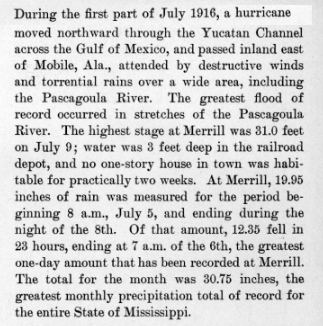
July 5th Hurricane of 1916
On the afternoon of July 5th in 1916, a Category 3 Hurricane struck near Pascagoula, MS. The maximum winds at landfall were 105 knots or approximately 121 mph. This hurricane produced the record-setting surge for the Mobile, AL area of 11.6 feet with 5.0 feet measured in Pensacola, FL and 6.3 feet measured on Fort Morgan, AL. According to the Monthly Weather Review, "On the morning of the 5th the storm center had moved across the Gulf with unusual rapidity and was near to and approaching the middle Gulf coast, and apparently somewhere between Mobile Bay and the mouth of the Mississippi River."
More from the Monthly Weather Review (link at the bottom of the page):
"In taking readings for special observations from roof apparatus at 8 a.m., 10 a.m., and 3 p.m., a rope was tied to the observer, W.F. Reed, jr.; no attempt was made to get to the instrument shelter or raingage at 1 p.m. when a 92-mile gale with severe puffs from the southeast was blowing..."
"Unfortunately, several lives were lost along the middle Gulf coast, mainly persons in small boats. Marine casualties were of a minor character but the aggregate losses amounted to several millions of dollars, distributed principally between the cities of Pensacola and Mobile and the agricultural sections of southeastern Mississippi and southwestern Alabama. The high tides were responsible for the major portion of the coast damage. At Mobile the tide was somewhat more than 2 feet above the previous highest tide of 9.87 feet about mean tide in September, 1906, and the entire business district was inundated. At Pensacola the tide was 5 feet above normal high tide, or 3 1/2 feet lower than the highest reached during the storm of September, 1906."
 An excerpt from the "Key to Meteorological Records Documentation, The Cooperative Weather Observer" in 1965 described the flooding that took place in southeast Mississippi during the hurricane:
An excerpt from the "Key to Meteorological Records Documentation, The Cooperative Weather Observer" in 1965 described the flooding that took place in southeast Mississippi during the hurricane:
"During the first part of July 1916, a hurricane moved northward through the Yucatan Channel across the Gulf of America, and passed inland east of Mobile, Ala., attended by destructive winds and torrential rains over a wide area, including the Pascagoula River. The greatest flood of record occurred in stretches of the Pascagoula River. The highest stage at Merrill was 31.0 feet on July 9; water was 3 feet deep in the railroad depot, and no one-story house in town was habitable for practically two weeks. At Merrill, 19.95 inches of rain was measured for the period beginning 8 a.m., July 5, and ending during the night of the 8th. Of that amount, 12.35 fell in 23 hours, ending at 7 a.m. of the 6th, the greatest one-day amount that has been recorded at Merrill. The total for the month was 30.75 inches, the greatest monthly precipitation total of record for the entire State of Mississippi."
NOTE: The hurricane was reanalyzed to retain the Category 3 impact for both Alabama and Mississippi.
Additional Information
Monthly Weather Review - July 1916
Acknowledgements: Page created by Morgan Barry (forecaster).
LAST UPDATED: July 2024